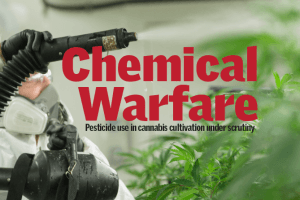urban-gro's J. Chandler, Vice President of Cultivation Technologies, offers his advice on how to avoid pests while remaining compliant in an ever-changing regulatory market. The cover story appeared in the July 2016 edition of Marijuana Business Magazine.

Chemical Warfare: Pesticide use in cannabis cultivation under scrutiny
by John Schroyer
Pesticides might not only kill mildew and mites on scores of cannabis plants in the coming years – they also could destroy countless marijuana businesses and stifle the industry’s growth along the way.
Industry professionals are increasingly sounding the alarm over the continuing widespread, largely unregulated use of pesticides in commercial cannabis cultivation, saying that a failure to address the situation at the state level might lead to a massive federal crackdown in the future, as well as legal issues and increased business costs for marijuana companies.
In many cases, growers are using pesticides that could prove poisonous to consumers, which has caught the attention of regulators in many states as of late.
One of the most controversial is Eagle 20, a longtime staple of cannabis growers who often battle powdery mildew. When heated, Eagle 20 releases hydrogen cyanide – not exactly a healthy substance to spray on cannabis plants that are likely to be smoked.
If a patient or marijuana user gets sick from ingesting pesticide-laced cannabis, the government could step in. Federal intervention could, in turn, “potentially stall or reverse the growth of this new agricultural industry altogether,” according to a scientific paper co-authored and published last year by Dr. Rodger Voelker, lab director of the MJ testing firm Oregon Grown Analytics, and Dr. Mowgli Holmes, the chief scientific officer at the marijuana genomics company Phylos Bioscience.
The big fear is that the federal government will deem pesticide use in the marijuana industry a public health risk, which could be seen as a direct violation of the 2013 Cole Memo from the Justice Department. The memo essentially paved the way for states to oversee the legal marijuana trade without worrying about federal intervention, as long as they meet eight key requirements. One of the requirements is that states and the industry itself must prevent “adverse public health consequences” to avoid federal scrutiny.
“States are allowing this to happen, potentially poisoning workers and consumers,” said Nic Easley, the CEO of Denver-based Comprehensive Cannabis Consulting. “That could give the federal government everything they need to come in and shut states down.”
The Situation and the Dangers
The U.S. Environmental Protection Agency is responsible for overseeing proper pesticide use in all other agricultural industries nationwide. But it hasn’t taken a stance on proper pesticide use for cannabis given that marijuana is still illegal federally. That means it’s up to the states.
However, a fair share of states with marijuana industries haven’t established regulations or procedures surrounding cannabis cultivation and pesticide use, or they are just now starting to take a look at the issue. The list includes California, Montana, Michigan, New Mexico and Rhode Island, among others.
A growing number are setting up their own pesticide regulations, in part to protect consumers and in part because of the federal government’s inaction. At least 13 states and the District of Columbia place some type of restriction on pesticide use for cannabis, whether it’s an outright prohibition on synthetic pesticides or mandated testing for pesticide residue before products are cleared for sale, according to a 2015 report by the nonprofit group Beyond Pesticides.
Regulators in Colorado, Oregon and Washington State have even put together rough lists of pesticides that can be used on cannabis.
But problems persist, even in states that are trying to address the issue.
In Nevada, for instance, testing failures led briefly last year to a shortage of supply, and at least part of that can be traced back to pesticide use. The lack of federal guidance and a resulting crackdown in Colorado has led to at least 43 marijuana product recalls in the state already, plus several more so-called “quarantines” of cannabis crops, all of which began in early 2015.
These problems have put pesticides in the spotlight, increasingly the likelihood that the federal government will step in.
“A government agency has not only the right, but essentially an obligation to ultimately weigh in, and if we don’t get ahead of that curve, the fear is they could come in a way that could derail much of what is being put into place,” Voelker told Marijuana Business Magazine.
With this as the backdrop, some pockets of the marijuana industry are trying to tackle the issue head-on. Increasingly, many cannabis cultivators are realizing that moving away from traditional pesticides isn’t just a matter of producing clean marijuana – it’s also good business. These growers are taking the initiative without being forced by state regulators because they realize the gravity of the situation.
That’s led a lot of companies, especially in western states, to alter their practices in favor of more natural growing methods, as synthetic pesticide use is quickly becoming a liability instead of an asset.
A survey early this year of cannabis professionals by Marijuana Business Daily found that 76% of wholesale growers claim they are using organic methods for some or all of the cannabis they produce. The actual percentage is likely much lower, as there are no set standards in the industry over what constitutes “organic” methods. Still, the figure shows that this is on the radar of many growers, and experts say the pressure from peers to avoid dangerous pesticides will increase sharply.
“(Growers) are going to be judged more harshly in the next few years in this industry … not just by the outside world, but particularly by those in the industry,” said Dale Sky Jones, executive chancellor of Oaksterdam University in California. “People aren’t going to want to work with people who get busted for doing stupid (stuff). You don’t want to be associated with that when you’re trying to keep your name clean.”
Lawsuits & Recalls
Aside from compliance and professional reputation, there are also potential legal liabilities and financial costs to using pesticides that will likely push cultivators to explore other options.
For instance, a product liability lawsuit was filed (and eventually dismissed in early 2016) against one of Colorado’s largest cannabis companies, LivWell Enlightened Health. In that case, the plaintiffs tried to argue that they would not have purchased cannabis from the company had they known that the pesticide Eagle 20 had been used during production.
Eagle 20 is a synthetic pesticide that is typically used to fight powdery mildew. It’s legal to use on ornamental plants as well as some fruits, such as grapes and apples. But a key ingredient in Eagle 20 is myclobutanil, which can transform into hydrogen cyanide when burned. Since burning is the most common form of ingestion with marijuana, Eagle 20 has become a flashpoint for cannabis growers and regulators.
The LivWell lawsuit was ultimately tossed because the two plaintiffs couldn’t demonstrate that they’d been harmed in any way, but it in many ways the case was a warning shot across the industry’s bow.
“At the time when those products were being used, specifically by us, it was an industry standard, and it had been an industry standard for 50 years,” said LivWell chief legal strategist Dean Heizer. “What we suffered from was not regulation. We were impacted by a lack of coherent regulation, with multiple agencies doing different stuff.”
Colorado’s rules have been evolving over the years, and the process is still underway. State lawmakers in May threw out a proposal to allow some growers to certify their cannabis as “organic.” Opponents suggested that allowing such a move could invite intervention from the U.S. Department of Agriculture, which oversees the legal use of the word “organic” on agricultural products.
While the LivWell lawsuit came to naught, Heizer said that if a future plaintiff could demonstrate actual harm caused by pesticide use, that could become a solid case that winds up in front of a jury. And that could result in serious damages being paid out by the guilty cultivator.
Prior to the lawsuit being filed, Heizer said, LivWell had already begun transitioning to using only pesticides that are certified by the Organic Materials Review Institute (OMRI), which was a deliberate business strategy.
“It was based on a considered decision to be more sustainable … it was an effort to make sure we were providing the safest, most wholesome product to our customers,” Heizer said.
Jake Salazar, the owner of another Colorado business that was hit by regulators because of a pesticide problem, said dealing with the fallout can be incredibly expensive. His company, MMJ America, was forced to place 100 clones on hold because a disgruntled employee reportedly sprayed a bunch of chemicals on the clones as she was departing. The company reported the incident to the state, which forced it to quarantine its plants for roughly six months before finally giving them the all-clear.
“I bet it cost us $50,000-$100,000, just because of the bad press that we didn’t deserve,” Salazar said. “It’s a huge brand image issue … People don’t read the fine print. You can go and prove yourself right and vindicate yourself, but there’s still that stigma.”
Denver attorney Sean McAllister, who has six clients currently dealing with pesticide-related regulatory issues, said such chemicals can prove a death knell to cannabis companies.
“It’s potentially life-threatening for the business,” McAllister said. “I’ve got clients on the verge of bankruptcy because of this problem.”
In Washington state, rules on pesticides used in cannabis cultivation have also been developing at a snail’s pace. Officials just approved rules allowing the state to recall marijuana products that are found to be tainted with pesticide residues. The state also established acceptable levels of pesticides that will allow it to set a testing regimen.
But as of press time, testing was not mandatory, meaning if consumers want to know if pesticides had been used in production, they’d have to ask.
And pesticides are still an issue: At least two large-scale cannabis producers – New Leaf Enterprises and BMF Washington – were forced to halt sales in December for using pesticides that were not on a state-issued list of approved products.
Options for Growers
So what can growers do in such an uncertain environment?
The good news is there are a lot of options, and many are cost effective.
The first step, many in the industry say, is to learn more about sustainable and natural ways to fight pests and related problems without using products like Eagle 20.
“A lot of older generation growers just aren’t knowledgeable and just don’t know how to fight (pests) without it. So they’re going to have to go through an education process, for sure,” said Wes Neal, the general operations manager at Wild West Growers in Oregon. “I fought that here. I got hired on in January, and the first thing I saw was Eagle 20, and I threw it all away immediately.”
The approved pesticide lists published by Colorado, Oregon and Washington state, for example, have hundreds of products named on their sites that growers can use (257 in Oregon alone). That’s where Neal starts when he’s forced to use pesticides. But he’ll also simply throw a plant away if it can’t be saved without toxic chemicals.
Growers in states without such lists can refer to the allowable pesticides in those three states as a good rule of thumb.
And there are more products on the way.
For example, Ashley Young, the owner of Clean Green Supply, has been busy marketing a product called Zonix, a biofungicide that he says can replace Eagle 20 in the fight against powdery mildew and root rot. It’s so natural and healthy, he said, that people could drink it directly from the bottle.
The product is often used by tomato growers and wine producers, and he’s been selling it to cannabis cultivators. A gallon costs $375, which is about $150 more than Eagle 20 costs online. But Young said growers have found that the benefit outweighs the increased costs.
The company has seen a boom in business over the past year, Young said, in large part because of the pesticide crackdowns in Colorado and new regulations in Oregon and Washington State.
“It’s been so effective that my best sales have been from word of mouth,” Young said. “I say, ‘You don’t have to pay me until you see how it works,’ and we usually wind up getting a re-order.”
Colorado-based urban-gro, an ancillary firm that caters to marijuana cultivators, is also marketing a new pesticide product called Procidic2, another option for battling powdery mildew that could replace Eagle 20 in many growers’ pest-fighting arsenals. Again, it’s a bit pricey at $346 a gallon, but the tradeoff is clean cannabis, and a gallon can treat between 3,000 and 6,000 plants.
Another option, especially for brand image, is to look into third-party certifications. Clean Green Certifications, for example, puts a stamp of approval on companies that pay it for inspections, and it indicates legal compliance and high-quality natural cannabis. The certification is available in California, Colorado, Nevada, Oregon and Washington State.
A similar program is offered in Colorado by the Organic Cannabis Association, which offers pesticide-free certifications for growers.
Growers looking for guidance from other industries can look to tobacco, for which the EPA has approved certain pesticides. But that might not be the best strategy, according to a research paper published by the nonprofit Beyond Pesticides.
“Unlike most packaged tobacco products, cannabis is not typically filtered when its smoke is inhaled, and therefore smokers may expose themselves to much higher levels of pesticides and degradates,” the paper reads.
Integrated Pest Management
Pesticides are only the beginning of what cultivators should take into consideration, said urban-gro Vice President John Chandler. Instead of focusing on chemicals, growers should really be considering pest problems – and solutions – from the outset.
Integrated pest management (IPM) is an ideal way to go, say many who are trying to solve the marijuana industry’s pesticide problem. It involves everything from climate control in indoor grows to building design and air flow.
“Integrated pest management is incorporating a number of different practices as a holistic approach to dealing with pests,” Chandler said. “If you wait to spray a pesticide until there’s a pest problem, that’s oftentimes very close to the end of flowering … and you wind up spraying a really toxic chemical right before harvest on this precious medicine.”
Some consultants are also well versed in IPM and are eager to talk about the subject, which means growers simply need to invest the time and energy to learn about what they can do.
Pesticides are not supposed to be used as preventative measures, only as a last resort, said Ethan Rubendall, a cultivator at California’s Fleurish Farms.
“I’ve seen firsthand (pests) that the grower can’t do anything about, with whatever they’re using,” Rubendall said. “But with implementing the proper IPM schedule, you can beat (pests).”
Cultivators also say there are plenty of ways to fight pests with organic methods, such as using neem oil, ginger, garlic and even chrysanthemum oil. Many of these options are far cheaper than products such as Zonix, Procidic2 or Eagle 20.
“If you haven’t accessed the resources, then you’re not trying, because there’s been a tremendous amount of education resources about sustainable practices out there,” said HappyDay Farms co-owner Casey O’Neill, who grows in the heart of northern California’s Mendocino County. “It’s adapt or die. If you can’t (grow) without spraying Eagle 20 and gnarly pesticides, then you ought to be out of business.”
Chandler of urban-gro said he has a list of around 75 different pesticides he’ll recommend to clients, depending on geographic location, type of pest, and numerous other factors.
Best of all, IPM is much more cost effective, said Easley, the Denver consultant. He said one of his clients in the long run saved over $500,000 by implementing about $2,500 worth of changes to its cultivation operation.
“You’ll make more money and potentially turn into an international brand” by using IPM, said Easley. “Or you could just cut corners and spray dangerous pesticides for a Band-Aid. But eventually, the wound is going to get infected, and it could kill the company. It’s done it already.”




